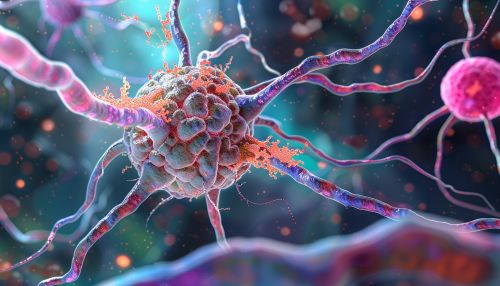NSF (protein)
Overview
The NSF protein, also known as N-ethylmaleimide-sensitive factor, is a crucial component in the cellular machinery that mediates vesicle fusion. It is a member of the AAA+ ATPase family and is involved in multiple cellular processes, including membrane fusion and vesicle trafficking. NSF protein is ubiquitously expressed in all eukaryotic cells and plays a vital role in maintaining cellular homeostasis.


Structure and Function
The NSF protein is a hexameric ATPase that consists of two distinct domains: an N-terminal domain (N domain) and two ATPase domains (D1 and D2). The N domain is involved in the interaction with soluble NSF attachment proteins (SNAPs) and the D1 and D2 domains are responsible for ATP hydrolysis, which provides the energy required for vesicle fusion.
NSF protein functions as a catalyst in the disassembly of the SNARE complex, a critical step in the vesicle fusion process. The SNARE complex is a four-helix bundle formed by the association of vesicle-associated membrane protein (VAMP), syntaxin, and SNAP-25. After membrane fusion, the SNARE complex is disassembled by the NSF protein, allowing the individual SNARE proteins to participate in subsequent rounds of fusion.
Role in Vesicle Trafficking
Vesicle trafficking is a fundamental process in eukaryotic cells, responsible for the delivery of proteins and lipids to their correct destinations. The NSF protein plays a pivotal role in this process by mediating the fusion of vesicles with their target membranes. This is achieved through the disassembly of the SNARE complex, which allows the vesicle to fuse with the target membrane and deliver its cargo.
NSF protein is also involved in the recycling of SNARE proteins. After the disassembly of the SNARE complex, the individual SNARE proteins are recycled back to their respective membranes, ready to participate in the next round of vesicle fusion. This recycling process is essential for maintaining the continuity of vesicle trafficking in the cell.
Clinical Significance
Mutations in the NSF protein have been linked to various neurological disorders. For example, a mutation in the NSF gene has been associated with the development of infantile epileptic encephalopathy, a severe form of epilepsy that begins in infancy. The mutation is believed to disrupt the normal function of the NSF protein, leading to abnormal vesicle trafficking and neurotransmitter release in the brain.
In addition, alterations in the expression of the NSF protein have been observed in several neurodegenerative diseases, including Alzheimer's disease and Parkinson's disease. These alterations may contribute to the pathogenesis of these diseases by disrupting normal vesicle trafficking and synaptic function.


